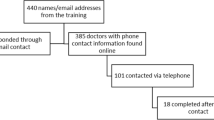Abstract
In the US, methadone maintenance is restricted by federal and state regulations to large specialized clinics that serve fewer than 20% of the heroin-dependent population. In Europe, Canada, and Australia, primary health care providers already are utilized widely as methadone prescribers. In preparation for a limited study of office-based methadone treatment in New York City, 71 providers from 11 sites were surveyed about their willingness to prescribes methadone in their office-based pratices. Of the 71, 85% had methadone-maintained patients who came to their practice for other care. One-third felt knowledgeable enough to prescribes methadone, and 66% said they would if given proper training and support (88% among AIDS care providers). Half expressed concern that they might be unable to meet the multiple needs of these patients. With additional training and ancillary support, the 47 providers willing to become methadone providers could serve, at 10–20 patients each, 470–940 patients, a population the size of 3–5 average methadone clinics.
Similar content being viewed by others
References
Nadelmann E, McNeely J, Drucker E. International perspectives. In: Lowinson JH, Ruiz P, Millman RB, Langrod JG, editors.Substance Abuse: a Comprehensive Textbook, 3rd ed. Baltimore, MD: Williams and Wilkins; 1997:22–39.
Farrell M.A Review of the Legislation, Regulation and Delivery of Methadone in 12 Member States of the European Union. Luxembourg: Office for Official Publications of the European Communities; 1996.
Sheridan J, Strang J, Barber N, Glanz A. Role of community pharmacies in relation to HIV prevention and drug misuse: findings from the 1995 national survey in England and Wales.BMJ. 1996;313(7052):272–274.
Muhleisen P, Lintzeris N, Koutroulis G et al. Evaluation of methadone dispensing in community pharmacies in VictoriaAust Pharm Suppl., 1998;17(8):7–12.
Drucker E, Lurie P, Wodak A, Alcabes P. Measuring harm reduction: the effects of needle and syringe exchange programs and methadone maintenance on the ecology of HIV.AIDS. 1998;12(suppl A):S217-S230.
US Food and Drug Administration. Sec. 291.501 and 291.505 (54 FR 8960, March 2, 1989; 54 FR 12531, March 27, 1989).
Institute of Medicine.Federal Regulation of Methadone Treatment. Rettig RA, Yarmolinsky A, editors. Washington, DC: National Academy Press; 1995.
Dole VP. Hazards of process regulations: the example of methadone maintenance.JAMA. 1976;267:2234–2235.
National Institutes of Health. Effective medical treatment of opiate addiction.NIH Consensus Statement. 1997 November 17–19;15(6):1–38.
Office of National Drug Control Policy.Consultation Document on Opioid Agonist Treatment. Washington, DC: ONDCP; 1998.
Wells P. GP prescribing: putting “shared care” policy into practice. Paper presented at:10th International Conference on the Reduction of Drug Related Harm. March 24, 1999. Geneva.
Novick DM, Pascarelli Ef, Joseph H et al. Methadone maintenance patients in general medical practice.JAMA. 1988;259:3299–3303.
Author information
Authors and Affiliations
Corresponding author
Rights and permissions
About this article
Cite this article
McNeely, J., Drucker, E., Hartel, D. et al. Office-based methadone prescribing: Acceptance by inner-city practitioners in New York. J Urban Health 77, 96–102 (2000). https://doi.org/10.1007/BF02350965
Issue Date:
DOI: https://doi.org/10.1007/BF02350965



